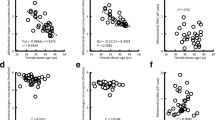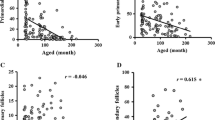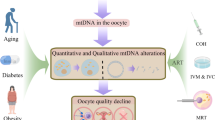Abstract
Mitochondria are organelles responsible for oxidative phosphorylation, the main energy source for all eukaryotic cells. In oocytes and embryos, it seems that mitochondria provide sufficient energy for fecundation by supporting spindle formation during meiosis II, and for implantation. Since mitochondria are inherited from mother to child, it is important that oocyte mitochondria should be intact. Older women seem to have more mitochondrial DNA mutations, which can be responsible for poor implantation and aneuploidy, two conditions that occur more often in this group. In the present report we propose a new model to explain why older women have poor implantation rates.
Similar content being viewed by others
References
Boettcher PJ, Kuhn MT, Freeman AE: Impacts of cytoplasmic inheritance on genetic evaluations. J Day Sci 1996;79:663-675
McGinnis KT, Diamond MP, Dozortsev DI: Simultaneous evaluation of morphology, mitochondrial mass, mitochondrial function and genetic complement in the preimplantation embryo. Fertil Steril 2001; 76:S240
Anderson AS, Banker AT, Barrel BG, de Bruijin MHL, Coulson AR, Drouin J: Sequence and organization of the human mitochondrial genome. Nature 1981;290:457-465
Ashley MV, Laipis PJ, Hauswirth WW: Rapid segregation of heteroplasmic bovine mitochondria. Nucleic Acids Res 1989;17:7325-7331
Smith LC, Bordignon V, Garcia JM, Meirelles FV: Mitochondrial genotype segregation and effects during mammalian development: Applications to biotechnology. Theriogenology 2000;53:35-46
Birky CW: Relaxed and stringent genomes: Why cytoplasmic genes don't obey Mendel's laws. J Hered 1994;85:355-365
Bendall KE, Macaulay VA, Baker Jr, Sykes BC: Heteroplasmic point mutations in the human mtDNA control region. Am J Genet 1996;59:1276-1287
Marchington DR, Macaulay V, Hartshorne GM, Barlow D, Poulton J: Evidence from human oocytes for a genetic bottleneck in a mtDNA disease. Am J Hum Genet 1998;63:769-775
Lee SH, Han JH, Kim HH, Lee SM, Chung MK, Cha KY: Semiquantitative analysis of common deletion in mitochondrial DNA of single human oocytes. Fertil Steril 2000;74:S194
Barritt JA, Cohen J, Brenner CA: The age related mitochondrial DNA control region point mutation (t414g) in human oocytes. Fertil Steril 2000;74:S3
Yesodi V, Yaron Y, Azem F, Lessing JB, Amit A: Mitochondrial DNA mutations in human oocytes: Correlation with IVF outcome. Fertil Steril 2000;74:S81
Sathananthan AH, Trounson AO: Mitochondrial morphology during preimplantation human embryogenesis. Hum Reprod 2000;15:148-159
Munné S, Alikani M, Tomkin G, Grifo J, Cohen J: Embryo morphology, developmental rates, and maternal age are correlated with chromosome abnormalities. Fertil Steril 1995;64:382-391
Dailey T, Dale B, Cohen J, Munné S: Association between nondisjunction and maternal age in meiosis II human oocytes. Am J Hum Genet 1996;59:176-184
Warburton D: The effect of maternal age on the frequency of trisomy: Change in meiosis or in utero selection? In Molecular and Cytogenetic Studies of Non-Dysjunction TJ Hassold, CJ Epstein (eds), New York, Liss, 1989, pp. 165-181
Salamanca-Gómez F: Reduced ovarian complement, premature ovarian failure and Down syndrome. Am J Med Genet 2001;99:168-169
Van Montfrans JM, Lambalk CB, van Hooff MHA, van Vugt JMG: Are elevated FSH concentrations in the pre-conceptional period a risk factor for Down's syndrome pregnancies? Hum Reprod 2001;16:1270-1273
Nasseri A, Mukherjee T, Grifo JA, Noyes N, Krey L, Coperman AB: Elevated day 3 serum follicle stimulating hormone and/or estradiol may predict fetal aneuploidy. Fertil Steril 1999;71:715-718
Freeman SB, Quanhe Y, Allran K, Taft LF, Sherman SL: Women with a reduced ovarian complement may have an increased risk for a child with Down Syndrome. Am J Hum Genet 2001;66:1680-1683
Winston N, Johnson M, Pickering S, Braude P: Parthogenetic activation and development of fresh and aged human oocytes. Fertil Steril 1991;56:904-912
Battaglia DE, Goodwin P, Klein NA: Influence of maternal age on meiotic spindle assembly in oocytes from naturally cycling women. Hum Reprod 1996;11:2217-2222
Takeuchi T, Gong J, Veeck LL, Rosenwaks Z, Palermo GD: Preliminary findings in germinal vesicle transplantation of immature human oocytes. Hum Reprod 2001;16:730-736
Cohen J, Scott R, Alikani M: Ooplasmic transfer in mature human oocytes. Mol Hum Reprod 1998;4:269-280
Barritt JA, Brenner CA, Malter HE, Cohen J: Mitochondria in human offspring derived from ooplasmic transplantation. Hum Reprod 2001;16:513-516
Hsieh R, Tsai N, Au H, Chang S, Cheng Y, Tzeng C: Multiple rearrangements of mitochondrial DNA and defective oxidative phosphorylation gene expression in unfertilized human oocytes. Fertil Steril 2001;76:S8
Wilding MG, Dale B, De Placido G: Confocal measurements of mitochondria activity during human pre-implantation embryo development. Fertil Steril 2001;76:S205
Magli MC, Jones GM, Gras L, Gianaroli L, Korman I, Trounson AO: Chromosome mosaicism in day 3 aneuploid embryos that develop to morphologically normal blastocysts in vitro. Hum Reprod 2000;15:1781-1786
Wang WH, Meng L, Hackett RJ, Odenbourg R, Keefe DL: The spindle observation and its relation with fertilization after intracytoplasmic sperm injection in living human oocytes. Fertil Steril 2001;75:348-353
Wang WH, Meng L, Hackett RJ, Keefe DL: Development ability of human oocytes with or without birefringent spindles imaged by Polscope before insemination. Hum Reprod 2001;16:1464-1468
Pickering SJ, Braude PR, Johnson MH, Cant A, Currie J: Transient cooling to room temperature can cause irreversible disruption of meiotic spindle in the human oocyte. Fertil Steril 1990;54:702-708
Schon EA: Mitochondrial genetics and disease. TIBS 2000;25:555-560
Sevidei S: Mitochondrial encephalomyopathies: Gene mutation. Neuromuscul Disord 2001;11:690-695
Han J, Lee S, Jun H, Park J, Kwak I, Cha K: Quantification of mitochondrial DNA and mitochondrial tRNA mutation at position 3243 in Korean gestational diabetes mellitus. Fertil Steril 2001;76:S158
Jones GM, Trounson AO, Lolatgis N, Wood C: Factors affecting the success of human blastocyst development and pregnancy following in vitro fertilization and embryo transfer. Fertil Steril 1998;70:1022-1029
Liu H, Zhang J, Krey LC, Grifo JA: In-vitro development of mouse zygotes following reconstruction by sequential transfer of germinal vesicles and haploid pronuclei. Hum Reprod 2000;15:1997-2002
Cummins JM: Cytoplasmic inheritance and its implications for animal biotechnology. Theriogenology 2001;55:1381-1399
Ménézo Y, Barak Y: Comparison between day-2 embryos obtained either from ICSI or resulting from short insemination IVF: Influence of maternal age. Hum Reprod 2000;15:1776-1780
Author information
Authors and Affiliations
Corresponding author
Rights and permissions
About this article
Cite this article
Bartmann, A.K., Romão, G.S., da Silveira Ramos, E. et al. Why Do Older Women Have Poor Implantation Rates? A Possible Role of the Mitochondria. J Assist Reprod Genet 21, 79–83 (2004). https://doi.org/10.1023/B:JARG.0000027018.02425.15
Issue Date:
DOI: https://doi.org/10.1023/B:JARG.0000027018.02425.15




